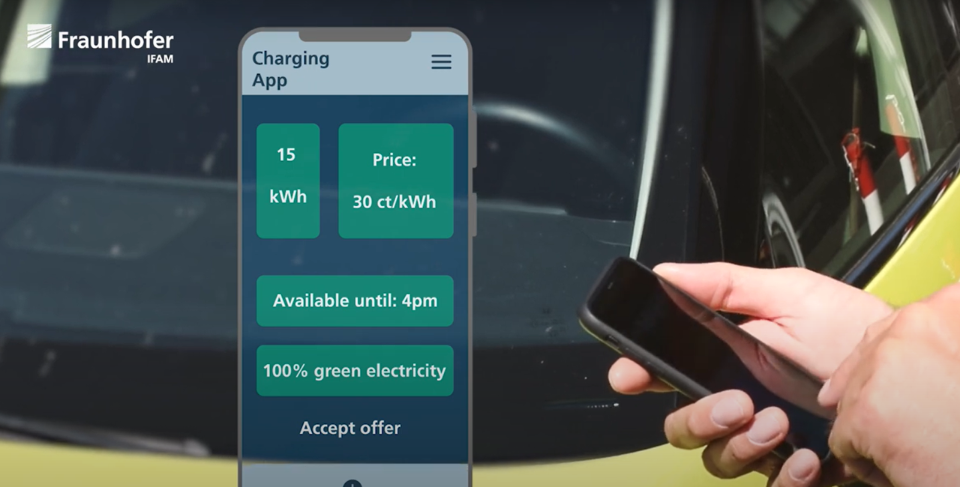Results of the "ROLLEN" research project
ELECTRIC CARS AS ROLLING CHARGING STATIONS: In the "ROLLEN" research project, Fraunhofer IFAM and its partners have shown how electric vehicles with bi-directional charging technology can store surplus energy from photovoltaic systems and pass it on in a targeted manner - to buildings, other electric vehicles or even to the public power grid.
In times of the energy transition, the need to find effective solutions for utilising renewable energies is becoming increasingly urgent. Homeowners with photovoltaic systems often generate more electricity than they consume themselves. If battery electric vehicles are therefore able not only to absorb electricity but also to deliver it (bi-directional charging technology), entirely new application possibilities and business models will emerge: Powering buildings (vehicle-to-home or vehicle-to-building), other electric vehicles (vehicle-to-vehicle) or feeding into the public power grid (vehicle-to-grid). In this context, the term V2X (vehicle-to-everything) technology is commonly used.
Statistically, this V2X approach is easy to implement: the average capacity of a traction battery is around 50kWh - enough energy for far more than the statistical daily requirement of around 40 kilometres of driving, which can already be covered with 4-6kWh. According to calculations by the project consortium, a homeowner with a 10kWp PV system and an annual electricity requirement of 5,000kWh can provide up to 1,500kWh per year for their building and an additional 1,100kWh per year for charging third-party e-vehicles (e.g. charging colleagues' e-vehicles at work), depending on their mobility profile. This can be financially compensated, which significantly increases the appeal of bi-directional charging technology.
Innovative business models thanks to billing using blockchain technology
The aim of the project was to optimise the geographical and temporal distribution of surplus energy from renewable energy systems (RE systems) using bi-directional electric vehicles (BEVs) with intelligent bidirectional charging technology.
A social study on user acceptance carried out as part of the project showed that this type of peer-to-peer energy exchange meets with great interest. Many participants showed a fundamental willingness to share their self-generated PV electricity with others - under the condition that the legal framework is clearly regulated and there are attractive financial incentives.
To be able to develop viable business models from the V2X scenarios, automated billing of the energy exchange between the energy supplier and the energy consumer is essential. This gives the energy supplier the opportunity to influence pricing and determine its own potential financial returns.
In the project, an app and platform for billing the energy flows was developed under the leadership of Honda. The advantages of decentralised blockchain technology are used to show the user the current share of green electricity in their vehicle battery and to invoice the energy transfer in a transparent and traceable way. The aim is to create a genuine user-to-user distribution system that works without dependence on third parties. The blockchain-based infrastructure enables verifiable and safe data storage - an important basis for an open, expandable system with a community approach.
Batteries on wheels: Electric vehicles relieve the power grid
The "ROLLEN" project also demonstrated that the bidirectional charging electric vehicles can help stabilise the power grid. For this purpose, the Fraunhofer IFAM in Bremen set up a practical test environment for the charging processes, in which the necessary hardware and software was installed, and the entire system was realistically tested. The data obtained was then analysed, evaluated and used for further development.
With the help of simulated calculations and hardware tests in the laboratories, it was possible to model how electric vehicles contribute to grid stabilisation. They act as virtual power lines: Energy is stored in the vehicle batteries, transported over distances and released elsewhere as required. As rolling charging stations, electric vehicles therefore play an important role in a flexible and resilient energy system.
Pioneering solutions for electromobility
Fraunhofer IFAM has extensive expertise and state-of-the-art equipment for research and development in the field of bi-directional charging. Our expertise and the results of this project provide a valuable basis for companies and potential cooperation partners interested in innovative solutions in the field of energy utilisation. If you would like to find out more about our research activities or are interested in working with us, please contact Dr. Stefan Lösch, Head of the department "Electric Drives & Charging Systems".
 Fraunhofer Institute for Manufacturing Technology and Advanced Materials IFAM
Fraunhofer Institute for Manufacturing Technology and Advanced Materials IFAM

